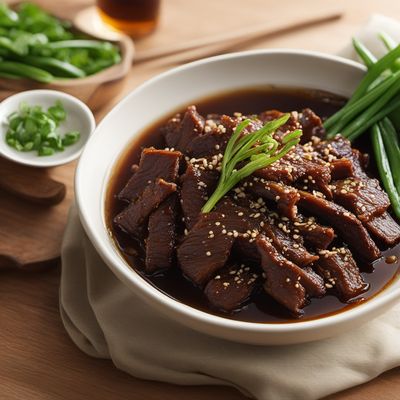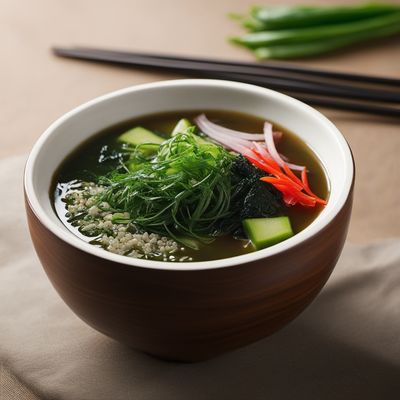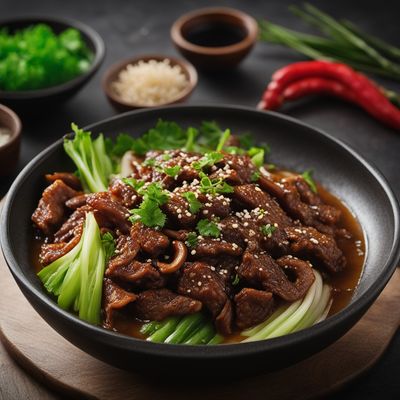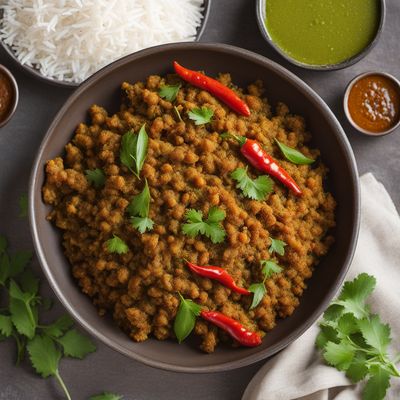
Recipe
Telugu-style Jangjorim
Spicy and Savory Telugu-style Beef Stew
4.3 out of 5
Telugu-style Jangjorim is a delicious and hearty beef stew that originates from the Telugu cuisine of South India. This flavorful dish is known for its rich spices and tender beef, making it a perfect choice for a satisfying meal.
Metadata
Preparation time
20 minutes
Cooking time
2 hours
Total time
2 hours 20 minutes
Yields
4 servings
Preparation difficulty
Medium
Suitable for
Non-vegetarian, Gluten-free, Dairy-free, Low-carb, High-protein
Allergens
Mustard seeds, Cumin seeds
Not suitable for
Vegetarian, Vegan, Paleo, Keto, Nut-free
Ingredients
In Telugu-style Jangjorim, we adapt the original Korean recipe to the Telugu cuisine by incorporating Telugu spices and flavors. The dish is made spicier by adding red chili powder and green chilies, which are commonly used in Telugu cuisine. Additionally, we use traditional Telugu cooking techniques to enhance the flavors and create a stew that is more suited to the Telugu palate. We alse have the original recipe for Jangjorim, so you can check it out.
-
500g (1.1 lb) beef, cut into bite-sized pieces 500g (1.1 lb) beef, cut into bite-sized pieces
-
2 onions, thinly sliced 2 onions, thinly sliced
-
4 cloves of garlic, minced 4 cloves of garlic, minced
-
1-inch piece of ginger, grated 1-inch piece of ginger, grated
-
2 green chilies, slit lengthwise 2 green chilies, slit lengthwise
-
2 tomatoes, chopped 2 tomatoes, chopped
-
1 tablespoon oil 1 tablespoon oil
-
1 teaspoon mustard seeds 1 teaspoon mustard seeds
-
1 teaspoon cumin seeds 1 teaspoon cumin seeds
-
1 teaspoon turmeric powder 1 teaspoon turmeric powder
-
1 tablespoon red chili powder 1 tablespoon red chili powder
-
1 tablespoon coriander powder 1 tablespoon coriander powder
-
Salt to taste Salt to taste
-
Fresh coriander leaves for garnish Fresh coriander leaves for garnish
Nutrition
- Calories (kcal / KJ): 350 kcal / 1465 KJ
- Fat (total, saturated): 15g, 5g
- Carbohydrates (total, sugars): 10g, 4g
- Protein: 45g
- Fiber: 2g
- Salt: 1.5g
Preparation
-
1.Heat oil in a large pan over medium heat. Add mustard seeds and cumin seeds. Once they start to splutter, add the sliced onions and sauté until golden brown.
-
2.Add minced garlic, grated ginger, and slit green chilies. Sauté for a minute until fragrant.
-
3.Add the beef pieces to the pan and cook until they are browned on all sides.
-
4.Add turmeric powder, red chili powder, coriander powder, and salt. Mix well to coat the beef with the spices.
-
5.Add chopped tomatoes and cook until they turn soft and mushy.
-
6.Pour enough water to cover the beef and bring it to a boil. Reduce the heat to low, cover the pan, and simmer for about 1.5 to 2 hours or until the beef is tender and the flavors have melded together.
-
7.Garnish with fresh coriander leaves and serve hot with steamed rice or roti.
Treat your ingredients with care...
- Beef — Choose a tender cut of beef, such as sirloin or chuck, for the best results. Trim any excess fat before cooking.
- Mustard seeds — Toasting the mustard seeds before adding them to the dish will enhance their flavor.
- Cumin seeds — Dry roast the cumin seeds in a pan for a few seconds to release their aroma.
Tips & Tricks
- For a spicier version, increase the amount of red chili powder or add additional green chilies.
- You can add vegetables like potatoes or carrots to the stew for added flavor and texture.
- Marinating the beef in yogurt and spices for a few hours before cooking can make it even more tender.
- Adjust the cooking time based on the desired tenderness of the beef.
- Leftovers can be refrigerated and enjoyed the next day, as the flavors tend to deepen and intensify.
Serving advice
Telugu-style Jangjorim is best served hot with steamed rice or roti. The flavorful gravy pairs well with the plain rice, allowing you to enjoy the rich flavors of the stew. Garnish with fresh coriander leaves for a pop of freshness.
Presentation advice
Serve Telugu-style Jangjorim in a deep bowl, allowing the thick gravy to surround the tender beef. Sprinkle some fresh coriander leaves on top for a vibrant touch. Pair it with a side of steamed rice or roti to complete the presentation.
More recipes...
For Korean cuisine » Browse all
More Korean cuisine dishes » Browse all

Kongnamul guk
Soybean sprout soup
Kongnamul guk is a traditional Korean soup made with soybean sprouts.

Dakbokkeumtang
Dakbokkeumtang is a Korean dish that is made with spicy chicken stew. It is a popular dish in Korea and is often served in restaurants and at home.
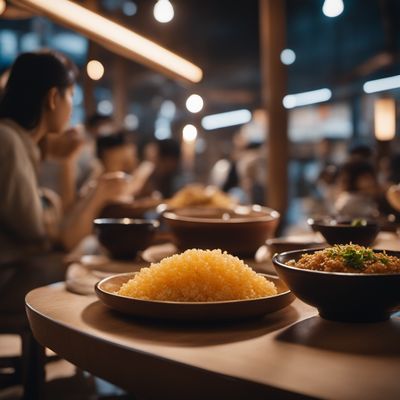
Nurungji
Crispy rice
Nurungji is a traditional Korean dish made from scorched rice. It is a simple and delicious dish that is often served as a snack or dessert.
